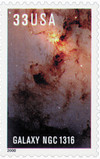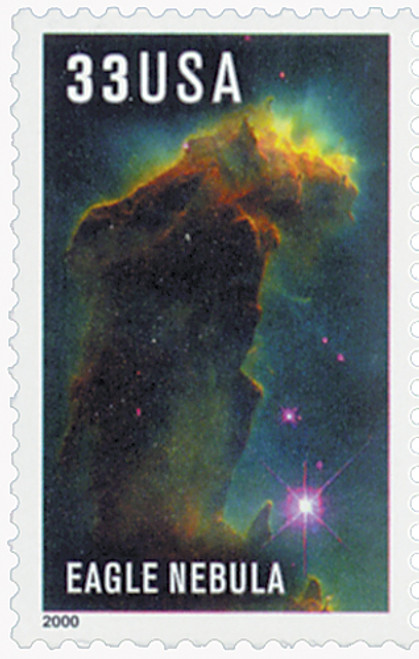
2000 33c Edwin Powell Hubble: Galaxy NGC1316
# 3388 - 2000 33c Edwin Powell Hubble: Galaxy NGC1316
$1.50 - $3.20
U.S. #3388
2000 33¢ Galaxy NGC 1316
Edwin Powell Hubble
2000 33¢ Galaxy NGC 1316
Edwin Powell Hubble
Issue Date: April 10, 2000
City: Greenbelt, MD
Quantity: 105,350,000
Printed By: American Packaging Corp. for Sennett Security Products
Printing Method: Photogravure
Perforations: 11
Color: Multicolored
City: Greenbelt, MD
Quantity: 105,350,000
Printed By: American Packaging Corp. for Sennett Security Products
Printing Method: Photogravure
Perforations: 11
Color: Multicolored
Galaxy NGC 1316 is a huge, elliptical galaxy located 53 million light years away in the southern constellation Fornax. The high-quality images taken by Hubble have led astronomers to some surprising conclusions.
Using Hubble photographs, scientists have identified a group of small and very faint stars within NGC 1316. Star clusters are common in spiral galaxies like our Milky Way, but not in elliptical galaxies like NGC 1316. This fact, combined with the silhouette of dark dust clouds against the growing center of the galaxy, may represent a 100 million year-old cosmic collision between NGC 1316 and a smaller galaxy.
Astronomers believe the star clusters are the last visible remains of the galaxy consumed by NGC 1316. A number of other objects, including reddish-color galaxies, are visible in Hubble’s image of NGC 1316.
Galaxy NGC 1316 is an extremely powerful source of radio waves, thought to be caused by a massive black hole at the galaxy’s center. The remains of the smaller galaxy are falling toward the center of NGC 1316, and may be providing the black hole with energy.
The Hubble image on this cover is the first picture of Saturn’s aurora. It was taken in 1997, when the planet was an astounding 810 million miles from Earth.
U.S. #3388
2000 33¢ Galaxy NGC 1316
Edwin Powell Hubble
2000 33¢ Galaxy NGC 1316
Edwin Powell Hubble
Issue Date: April 10, 2000
City: Greenbelt, MD
Quantity: 105,350,000
Printed By: American Packaging Corp. for Sennett Security Products
Printing Method: Photogravure
Perforations: 11
Color: Multicolored
City: Greenbelt, MD
Quantity: 105,350,000
Printed By: American Packaging Corp. for Sennett Security Products
Printing Method: Photogravure
Perforations: 11
Color: Multicolored
Galaxy NGC 1316 is a huge, elliptical galaxy located 53 million light years away in the southern constellation Fornax. The high-quality images taken by Hubble have led astronomers to some surprising conclusions.
Using Hubble photographs, scientists have identified a group of small and very faint stars within NGC 1316. Star clusters are common in spiral galaxies like our Milky Way, but not in elliptical galaxies like NGC 1316. This fact, combined with the silhouette of dark dust clouds against the growing center of the galaxy, may represent a 100 million year-old cosmic collision between NGC 1316 and a smaller galaxy.
Astronomers believe the star clusters are the last visible remains of the galaxy consumed by NGC 1316. A number of other objects, including reddish-color galaxies, are visible in Hubble’s image of NGC 1316.
Galaxy NGC 1316 is an extremely powerful source of radio waves, thought to be caused by a massive black hole at the galaxy’s center. The remains of the smaller galaxy are falling toward the center of NGC 1316, and may be providing the black hole with energy.
The Hubble image on this cover is the first picture of Saturn’s aurora. It was taken in 1997, when the planet was an astounding 810 million miles from Earth.













